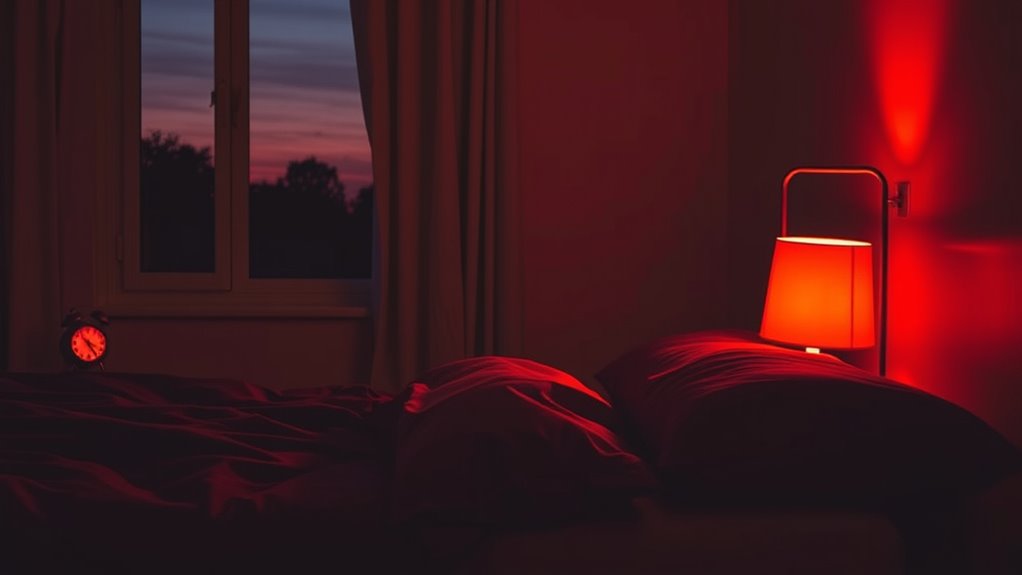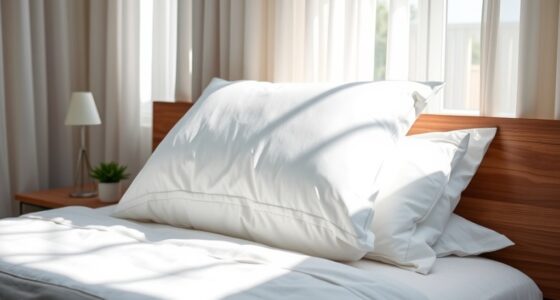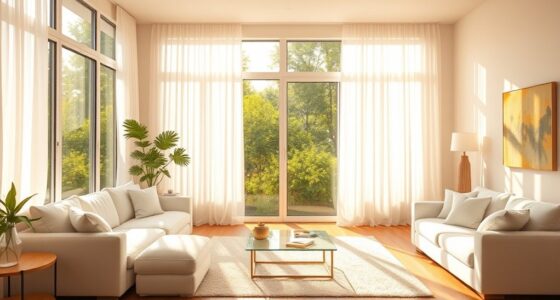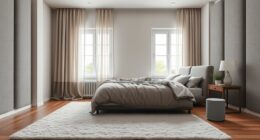To promote melatonin production and improve sleep, it’s best to reduce blue light exposure before bed. Avoid screens like phones, tablets, and computers at least an hour before sleep, or use blue light filters on your devices. Switch to dim, warm-colored lighting such as amber or red bulbs in your evening hours. Creating this calming environment helps signal your body that it’s time to wind down. Keep exploring to discover more ways to optimize your sleep environment.
Key Takeaways
- Use dim, warm-colored lighting such as red or amber bulbs in the evening to minimize blue light exposure.
- Turn off or dim screens at least one hour before bedtime to reduce blue light interference.
- Opt for red or orange night lights during pre-sleep routines to promote melatonin production.
- Incorporate dimmable lamps or specialized bulbs with low blue emission into your evening lighting setup.
- Establish a consistent routine of reducing blue light exposure to support natural sleep cycles and melatonin levels.
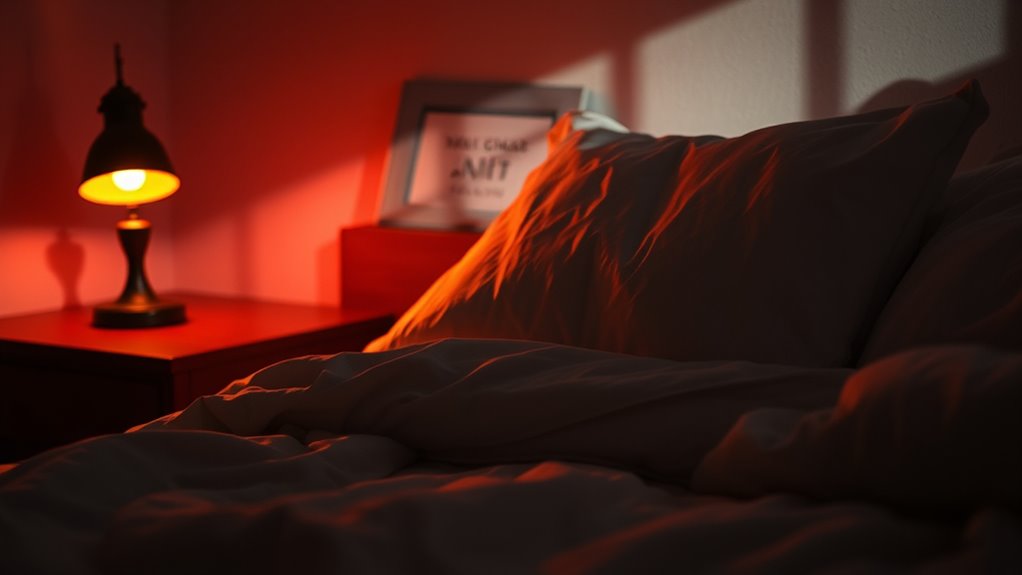
Preparing your environment with the right lighting before bed can considerably improve your sleep quality. One key factor is managing how light affects your circadian rhythm, the internal clock that regulates your sleep-wake cycle. When your circadian rhythm stays aligned with natural light patterns, you fall asleep faster and experience more restful sleep. Exposure to certain light spectra, especially blue light, can disrupt this rhythm, making it harder for your body to produce melatonin, the hormone responsible for signaling sleep. To optimize your pre-sleep environment, you should focus on reducing exposure to blue light and favoring warmer, dimmer lighting.
During the evening, your eyes are particularly sensitive to the light spectrum, especially blue wavelengths emitted by screens and artificial lighting. These blue wavelengths trick your brain into thinking it’s still daytime, suppressing melatonin production and delaying sleep onset. To counteract this, you need to shift your lighting to a warmer spectrum, such as amber or red hues, which are less likely to interfere with your circadian rhythm. Using dim, warm-colored lights in your bedroom signals to your brain that it’s time to wind down, promoting natural melatonin release. This simple change sets the stage for better sleep quality, helping you fall asleep faster and stay asleep longer.
Shift to warm, dim lighting in the evening to promote melatonin and improve sleep quality.
Adjusting your lighting environment is also about consistency. Establishing a routine where you turn off bright, blue-enriched lights at least an hour before bed reinforces your body’s natural sleep signals. You might consider using dimmable lamps, amber night lights, or even specialized bulbs designed to emit a light spectrum that minimizes blue wavelengths. If you need some illumination, opt for red or orange bulbs, which have minimal impact on melatonin levels. This consistency helps your circadian rhythm stay synchronized with the natural day-night cycle, making it easier for your body to transition into sleep mode.
Finally, it’s important to be mindful of your overall light exposure in the hours leading up to bedtime. Limit screen time and avoid bright indoor lighting when possible. Instead, create a calming environment with soft, warm lighting. Reducing blue light exposure is crucial in maintaining healthy circadian rhythm, which supports your body’s natural sleep processes. This not only reduces the blue light spectrum’s influence but also signals your body that it’s time to wind down. By paying attention to your pre-sleep lighting environment, you’re supporting your circadian rhythm and allowing melatonin to do its job effectively. In turn, you’ll enjoy deeper, more restorative sleep, waking up refreshed and ready for the day ahead.
Frequently Asked Questions
How Long Before Sleep Should I Reduce Blue Light Exposure?
You should start reducing blue light exposure about 1 to 2 hours before bedtime. Limiting screen time during this period helps improve your sleep hygiene by allowing melatonin production to naturally increase. Use red or dim lighting instead of bright screens, and consider wearing blue light blocking glasses. This practice can help you fall asleep faster and enjoy more restorative sleep, making your nightly routine more effective.
Are There Specific Red Light Devices Recommended for Pre-Sleep Use?
Think of red light devices as your personal sunset, gently signaling your body it’s time to wind down. For pre-sleep lighting, choose devices with adjustable red LEDs or filtered lamps designed for relaxation. Brands like Lumos or Caspar offer popular options. These devices emit a warm, calming glow, helping you avoid blue light’s interference with melatonin. Incorporate them into your nightly routine to ease into restful sleep naturally.
Can Blue Light Reduction Improve Sleep Quality in Shift Workers?
Yes, reducing blue light can improve your sleep quality by minimizing circadian disruption. When you limit blue light exposure, especially from screens and bright lights, your body produces more melatonin, making it easier to fall asleep. Light therapy using red or dim lighting helps support your natural sleep cycle during shift work, promoting better rest and overall health. Incorporate these strategies to manage circadian disruption effectively.
What Are the Potential Risks of Using Red Light at Night?
Using red light at night can decrease your light sensitivity and help minimize circadian disruption, but it might also limit your ability to see clearly in low-light conditions, increasing your risk of accidents. Some people may experience difficulty adjusting to red light if their eyes are sensitive or if they’re used to brighter lighting. Always consider your environment and personal sensitivity to avoid potential risks while benefiting from red light use.
How Does Blue Light Affect Melatonin Levels Compared to Other Wavelengths?
Blue light markedly suppresses melatonin production compared to other wavelengths, which can delay sleep onset and disrupt your circadian rhythm. When you’re exposed to blue light at night, it interferes with melatonin levels more than red or amber light, leading to circadian disruption. This makes it harder for your body to prepare for sleep, affecting sleep quality and overall health. To promote better sleep, limit blue light exposure in the evening.
Conclusion
By gently dimming your lights before bed, you can create a cozy environment that whispers softly for your body to wind down. Reducing blue light isn’t about restriction—it’s about inviting a peaceful shift into restful sleep. Embrace these small changes, and you might find your nights become a gentle retreat, guiding you toward sweet dreams and refreshed mornings. After all, a little kindness to your eyes could be the secret to waking up feeling your best.
